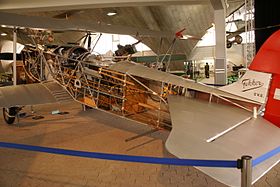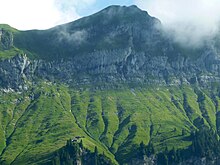Air accident at the Muotathaler Heuberge
| Air accident at the Muotathaler Heuberge | |
|---|---|
|
Fokker CV-E in the Swiss Aviation Museum . |
|
| Accident summary | |
| Accident type | Controlled flight into terrain ( CFIT ) |
| place | Muotathaler Heuberge |
| date | August 27, 1938 |
| Fatalities | 7th |
| Survivors | 1 |
| Injured | 1 |
| Aircraft | |
| Aircraft type | Fokker CV-E |
| operator | Swiss Air Force |
| Mark | C-311, C-319, C-337, C-356 |
| Departure airport | Dübendorf military airfield , Dübendorf , Switzerland |
| Destination airport | Bellinzona Airfield, Bellinzona , Switzerland |
| Passengers | 0 |
| crew | 8th |
| Lists of aviation accidents | |
In the flight accident at the Muotathaler Heuberge on August 27, 1938 four of five aircraft in a formation of Fokker CV-E fighter planes of the Fliegerstaffel 10 of the Swiss Air Force crashed on the Heubergen in Muotathal . The planes were to be transferred to the Bellinzona airfield and should have taken part in the Lugano International Flight Days the next day . To date, it is the largest accident in the Swiss Air Force.
the accident
The five two-seater aircraft took off at 3:33 p.m. on Saturday afternoon from the Dübendorf military airfield and flew in a wedge-shaped formation with visual contact towards the Alps. A direction finding exercise from Dübendorf to Disentis was planned. At that time, thick clouds were hanging in the area of the Heuberge in the Muotathal, which the commander, Captain Décio Bacilieri, also noticed.
In order to counter the risk of a collision in the clouds, the commander ordered a wide right turn to return to Dübendorf above the Muotathal at an altitude of around 2000 meters. During this maneuver, however, the formation got caught in thick clouds and fog. After crossing the Heuberge, the crest of which is 1700-2200 meters above sea level, Captain Bacilieri's plane slipped sideways, crashed at 1900 meters on the northwest slope of the Drusberg ( CH1903 706'100 / 207'300) and caught fire . Bacilieri and his observer H. Sommerhalder survived seriously injured and were able to get help on their own. Décio Bacilieri died later, on September 7, 1938, of the consequences of the accident in Einsiedeln Hospital .
Three of the four other aircraft crashed on the southern slopes of the Heuberge at altitudes between 1400 and 1680 meters ( CH1903 703,000 / 205,600, 703,700 / 205,800 and 702,100 / 205,700). All six crew members were killed. The plane that was not involved in the accident later landed in Bellinzona.
consequences
After the accident, the obsolete aircraft were withdrawn from active service. In addition, the training of the pilots has been improved.
A memorial in Muotathal, a small exhibition and a memorial stone for Captain Bacilieri at the Locarno airport and Via Decio Bacilieri in Minusio are reminiscent of the accident. In addition, the unofficial anthem of the Swiss Air Force, the song "Voglio Volare" by Waldes Keller, emerged from this accident.
Web links
- Website about air accidents in Switzerland
- Southeastern Switzerland from August 27, 2013: The airplane drama on the Heuberge
Individual evidence
- ↑ a b c d e Erich Aschwanden: It should be an advertising campaign, but then a flight in the Schwyz mountains 80 years ago will be the greatest disaster in the history of the Swiss Air Force | NZZ . In: Neue Zürcher Zeitung . ( nzz.ch [accessed on August 27, 2018]).
- ↑ a b c Fabienne Meyer: Monuments for crashes, kills and accidents in Swiss military aviation . Ed .: Swiss Air Force. Bern, S. 140–150 ( admin.ch [PDF]).
- ↑ NZZ of August 27, 2018: Eighty years ago, the most serious disaster of the Swiss Air Force occurred
- ↑ Voglio Volare interpreted by Christel Balzano and Sebalter
Coordinates: 47 ° 0 '29.7 " N , 8 ° 50' 2.2" E ; CH1903: 706.1 thousand / 207299

